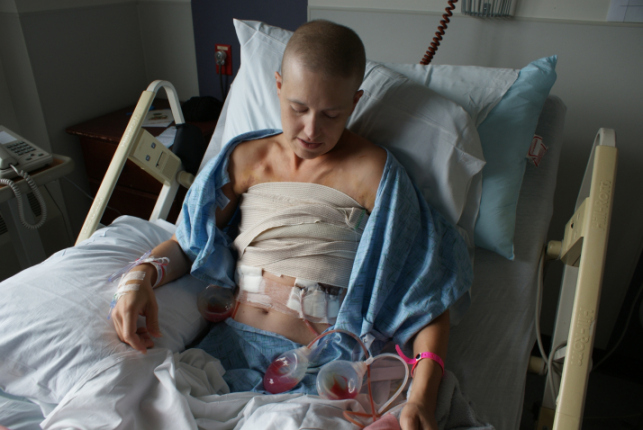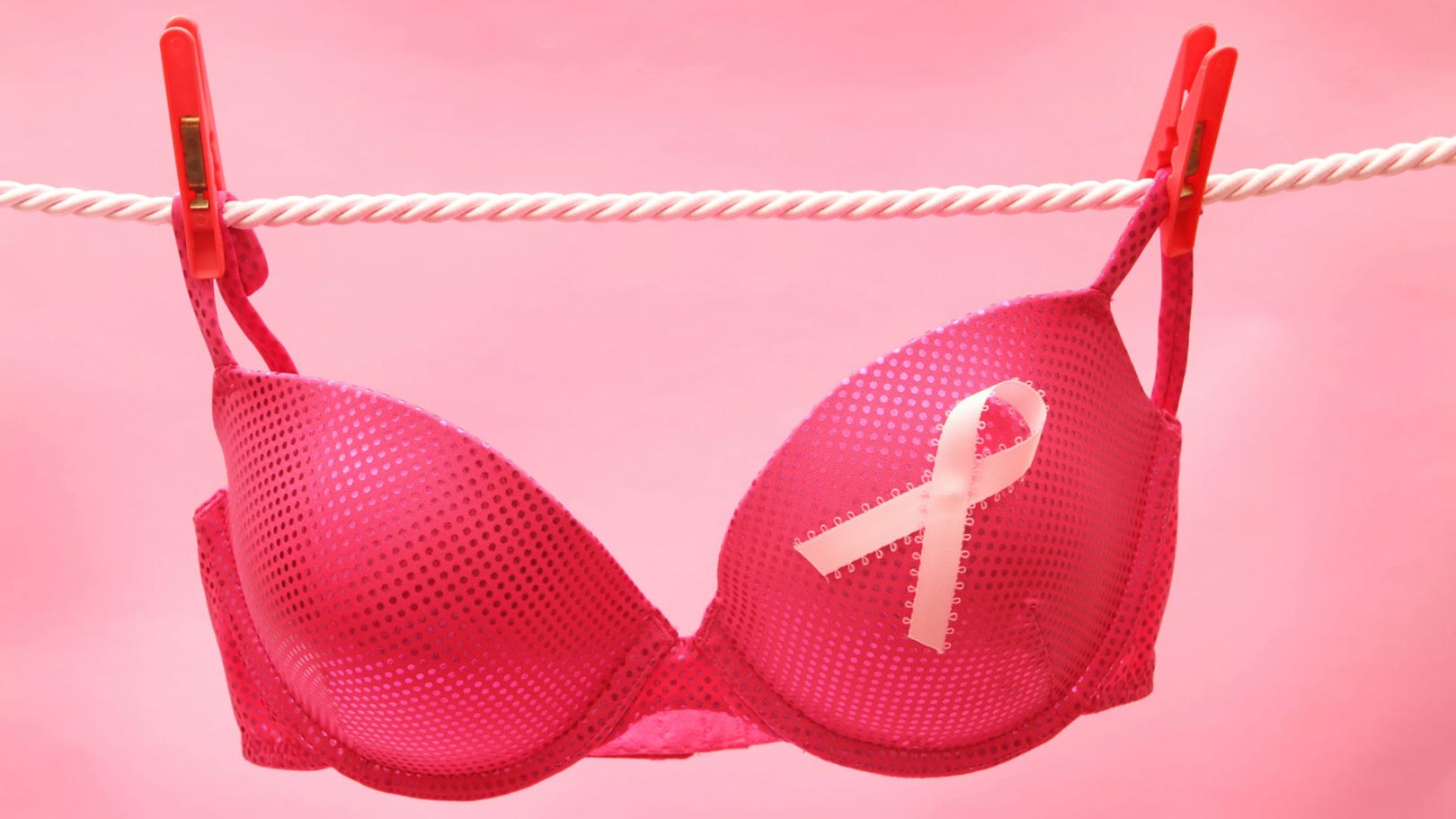by Leisha Davison-Yasol
I am not a ranter by any means and I have been pretty quiet about “Pinktober” and what has come to be known as “Pinkwashing” in breast cancer circles, but seeing that October 13th was advertised as “National No Bra Day” and as a “fun” way to support people with breast cancer has pushed me over the edge.
Are you kidding me? How on earth could a day where girls and women are encouraged to post and share photos of their braless breasts and to walk around with their nipples poking through their shirts be “supportive” for women who are living with or who have died from breast cancer, or who have managed to ‘complete’ the arduous treatments and disfiguring surgeries required to put them into remission?
I think the answer is simple. It is not.
Like so many women — and men — who have faced this disease, I have lost my breasts to cancer. Though I had a terrific surgeon, it was a physically and emotionally disfiguring surgery.
The cancer had gone so deep and was so extensive on my left side that it was at first inoperable. Even after months of chemo, my surgeon took as much tissue and skin as possible and went deep into my axilla (underarm area). The cancer had metastasized to my lymph nodes and had invaded them to such a degree that they broke open to allow the cancer cells to go beyond the walls of the nodes. Because of how invasive the surgery was and of how much nerve damage, etc. resulted, it was not only extremely painful then, but continues to be a source of pain and phantom sensations that affect my entire upper torso even today.
I required over a year of physical therapy just to be able to raise my arms again and I still don’t have full function or range of motion. And, because of pain, swelling, conspicuous compression sleeves and gloves, I am constantly reminded of the lymphedema that resulted from the surgery and loss of my lymph nodes. Oh, and the life-threatening infections that forced a couple of hospitalizations and four months of massive doses of antibiotics this summer (almost 2 years after my original surgery), are also a little reminder of some of the things that the bilateral mastectomy and lymph node surgeries have left me with. And there is so much more…
So the thought of seeing bra-less women flaunting two body parts that I have lost to cancer — more than I already see this on a regular day — does not feel all that supportive. In fact, it feels quite the opposite.
I think of myself as an open-minded person. I do my best not to judge others or their beliefs and ideals. I have a pretty good sense of humor and am usually the first to poke fun at myself. And I make light of breast cancer and my struggles, treatments and their side effects, lack of breasts, fear of death, etc. fairly frequently. It is how I cope. But, given what I have been through, I think I have earned the right to joke and make light of how this terrible disease has affected me. But if you haven’t been there or taken care of someone who has been there, then you should think twice before you publicize a day that jokes about putting the first body parts we usually lose to this disease “out there” on display even more conspicuously and then labeling it as an activity that helps our “cause.”
We live in a society that makes a huge hoopla about breast cancer while at the very same time trivializing the seriousness of the disease. How can we be so contradictory?
While I am beyond thrilled that breast cancer is no longer a taboo issue and that people are talking about it, the commercialism has gotten out of hand. There is nothing pink and rosy about breast cancer, yet it has been pink-washed to death. It is a serious disease that kills.
And while I do think we need more awareness and education (about metastatic disease, about how young women can develop breast cancer, about how women (young and old) DO die from this disease, about the importance of research, etc.), I don’t think we need the kind of awareness that buying a jar of salsa with a pink ribbon on it brings. While I hardly ever see “awareness” products addressing the topics above, I can’t go anywhere without seeing pink products. Heck, I just have to look out of my front window to see giant pink garbage totes. The stores are filled with pink as companies try to make a buck off breast cancer. If you look carefully at these products, you’ll find that some of them don’t even donate a cent to breast cancer awareness, support, research, etc. And oftentimes those that do make a very minimal donation-and not always to organizations/programs where the money is well spent.
What is most unfortunate is that well-meaning people are willing to buy pink products, even pay a little extra, because they think they are helping to do something to “cure” breast cancer or to provide “hope” to breast cancer patients. Why is this sad? Because those dollars spent on pink flowers, pink shirts, or a pink box of crackers or spaghetti sauce could be going to research, our only real “hope” of beating this horrible disease.
My intention is not to offend or to hurt the feelings of anyone who is genuinely trying to help, but I think it is important for you to know the truth. So please put your bra back on, put down those pink garbage bags (unless you really like pink that much!), that pink “awareness” pepper spray keychain, and that pink breast cancer “awareness” vibrator and dildo (yes, I’m blushing and yes, these are real things that their merchandisers say will “help you raise breast cancer awareness” — though they are shipped discretely in plain, unmarked boxes so no one knows what you purchased) and send a few dollars to an organization that devotes their fundraising dollars to research. You just have to do a bit of homework or read the labels on those pink items to see where your money is actually going. (There are pink products out there that do help to fund research, etc. — they seem to be in the minority, but they do exist.) But, if you don’t like homework, here are three great organizations — there are many others, but these are some of my favorites:
Stand Up to Cancer: This is a terrific one — and it’s not just for breast cancer, but all cancers. Our mission is to fund collaborative, translational cancer research to bring treatments from the bench to the bedside faster, and save lives now. Since Stand Up To Cancer was founded in May 2008, we have granted $161 Million Dollars to ten Dream Teams of scientists and researchers, one international translational research team and 26 high-risk, high-reward Innovative Research Grants. 100% of public funds go directly into research grants. A portion of the funds that are raised from major donations and third-party fundraising go towards administrative expenses and overhead.
Metavivor.org: From support groups to funding vital research, our programs sustain the power of hope. Passionately committed patients ourselves, we rally public attention to the urgent needs of the metastatic breast cancer (MBC) community, help patients find strength through support and purpose, and make EVERY dollar count as we work with researchers to regain longevity with quality of life.
Inflammatory Breast Cancer (IBC): is a rare and highly fatal form of breast cancer that is not typically discovered by mammogram and often occurs prior to standard breast cancer screening age recommendations. Our all volunteer board is focused on education and funding research for this 200 year old orphaned form of breast cancer. No Lump Still Cancer.
A number of people have emailed or commented about how Young Survival Coalition (YSC) has helped them. This organization is the premier global organization dedicated to the critical issues unique to young women who are diagnosed with breast cancer. YSC offers resources, connections and outreach so women feel supported, empowered and hopeful.
… or consider a group that helps cancer patients and their families cope with their illness. For example:
CancerIsAJerk.org: This is a small charity my dear friend jme set up to help families affected by cancer. You can make a financial donation or purchase “Cancer Is a Jerk” t-shirts with all proceeds going to help actual families affected by cancer. You can also contact jme through the charity if you’d like to sell shirts as a fundraiser with all proceeds going to benefit cancer family applicants in general OR designate a specific family of your choosing. And if you know a cancer family in need, please encourage them to apply for assistance.
And don’t underestimate the value of local organizations. My local Breast Cancer Coalition is a perfect example. The Breast Cancer Coalition of Rochester’s mission is to make the eradication of breast cancer a priority through education and advocacy; to empower women and men to participate fully in decisions relating to breast cancer; to provide support to those coping with a breast cancer diagnosis; and to focus research into the causes, prevention, treatment and cure of breast cancer.
Also local for me is The Karen Carson Crane Foundation. Founded by Karen’s siblings after she died of breast cancer, the mission of the Karen Carson Crane Foundation (“the KCC Foundation”) is to provide support and financial assistance for individuals affected by breast cancer; to encourage breast cancer patients to have the strength, courage and passion to overcome their disease; to support local organizations that assist breast cancer patients; and to donate a portion of its fundraising dollars to organizations that research and promote alternative cancer treatment methods.
There are many other great organizations and groups out there — these are just a few.
And if you can’t help with a financial donation, consider volunteering your time or talents. Perhaps to local cancer patients — bringing a meal or knitting a chemo cap or scarf, or sending a cozy blanket are examples of ways to show your support. I remember when a small box of craft supplies was left on my doorstep when I was first going through chemo — what a gift that was — my kids loved it and it kept them occupied for a little while when I was really ill! Or consider volunteering at a local cancer center or for a local American Cancer Society chapter. There are many ways to show your support that don’t require $$.
—
And, of course, don’t forget to go for your regular mammograms and to feel your breasts when you can (and report any changes to your doctor) because doing these things IS important. It is how I found my own lumps, almost 18 years before I was due for my first mammogram (according to the recommended screening age back in 2009). While the vast majority of lumps are benign, I still believe it’s always best to bring your breast changes to the attention of your doctor. Thanks for reading…
I will leave you with a picture that I think is my best advertisement for Breast Cancer Awareness Month.

Leisha Davison-Yasol is a blogger. Her blog is Cancer In My Thirties. This piece is culled from HuffPost.
Opinions express in this article are solely those of the author.







